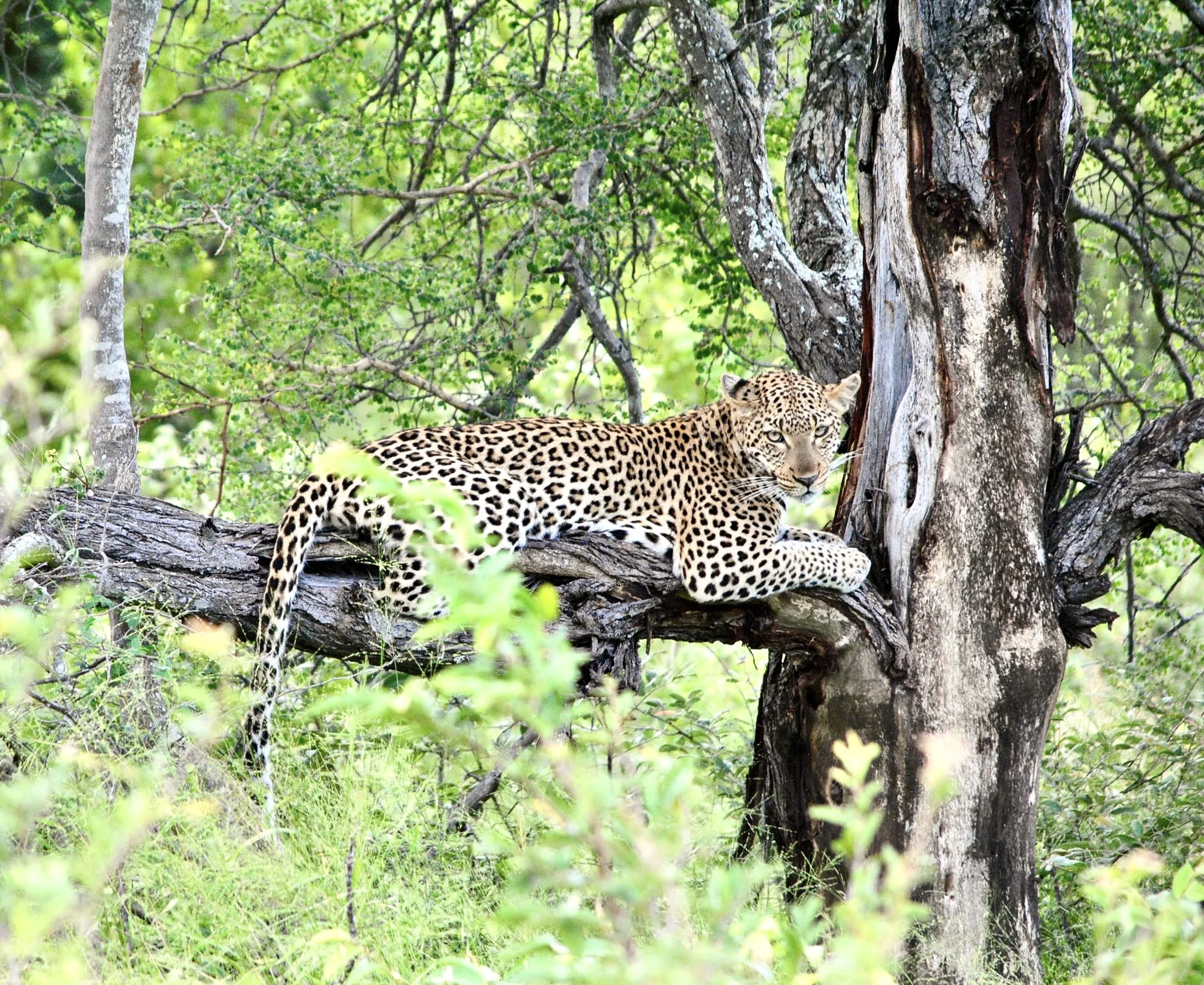The Thrill, the Stillness, and the Wonder: Why Safari Stays With You
Safaris are some of my favorite adventures to design, because they are truly life-changing. There’s nothing quite like hearing the bush come alive at dawn, spotting a herd of elephants emerging from the treeline, or watching the sun set over a golden savanna while hippos bellow in the distance. Every day brings its own surprises — the kind that remind us why we travel in the first place. And sharing experiences like these is exactly why I started East of Ordinary: to design journeys that move you, connect you, and stay with you long after you’ve returned home.
One of the Klaserie Nature Reserve’s resident leopards, Xivindzi—meaning “brave” in the local Xitsonga language—lounges peacefully in a tree adjacent to our safari vehicle. Our 30-minute shared hangout one morning was a highlight of the trip.
The Magic of Safari
There aren’t many things that get me out of bed with excitement for a 4:45 a.m. departure. But on my very first morning on safari, there I was: waking in the dark to an unwelcome alarm, pulling on hiking pants and a fleece, brushing my teeth half-asleep, grabbing my camera bag, and wandering toward the main lodge at South Africa’s Klaserie Drift safari camp, located on a private game reserve in the Greater Kruger National Park.
Bleary-eyed, I hoisted myself into the open-sided safari vehicle, still wondering why it was precisely necessary to begin at such an uncivilized hour. Dawn was just breaking as our private guide, Matt, started the engine and eased us onto the dirt track.
That was the first and only time I’d approach a safari morning with a lack of enthusiasm. From that day forward I woke eagerly, urgent to begin the adventure that awaited. On that first drive, the lavender sky stretched wide over the landscape as birds began to stir. At Matt’s urging, to-go cappuccinos in hand, we scanned the trees along the Klaserie River for leopards. I didn’t know it yet, but this was the beginning of a rhythm I’d come to crave: watching, listening, attuning to every rustle, shadow, and call as the bushveld comes out of its slumber.
Our safari guide, Matt—much beloved and feeling like a old friend by the end of our stay—traverses a wash to assess its suitability for crossing.
Possibility at Every Turn
Safari is an unwitting exercise in mindfulness. You’re forced to slow down, trust your senses, and focus entirely on the world around you. And yet, it’s electrifying; every turn of the track holds possibility. One afternoon, after a conversation with Matt about the complexities of rhino conservation, we rounded a bend to find a small family of these horned titans: two adults and a calf, grazing peacefully in the tall grass. A rainbow arced above them as they ambled off — a scene so perfect it felt imagined.
Most encounters brimmed with peaceful awe, but safari isn’t complete without moments that humble you. Locking eyes with a massive lioness as she sauntered right beside the open vehicle. Watching our guide hit the accelerator to put space between us and two young elephant bulls mid-tussle on the roadside. The bush has a way of reminding you just how small we humans are.
Elusive and solitary, discovering a few of the Klaserie’s rhinos was a special privilege. While more than three-quarters of the rhino population in the Greater Kruger had disappeared due to poaching, in recent years stringent protection efforts have paid off.
Guided by Intimacy and Knowledge
Part of the magic was the expertise that surrounded us. Matt seemed impossible to stump; his knowledge of birds, insects, plants, animal behavior, and even tracks in the sand was encyclopedic, but delivered with warmth and humor. He read the land like a language, sharing its stories in real time.
And he wasn’t working alone. In the Klaserie, a private reserve within the Greater Kruger National Park, conservation isn’t just a philosophy — it’s a daily practice. Strict rules limit how many vehicles can approach an animal, and guides coordinate with incredible precision to ensure wildlife is respected and undisturbed. The balance struck here — between allowing humans to witness and protecting the animals’ right to live freely — is part of what makes the experience so powerful.
The Cocktail Hour to End All Cocktail Hours
Evenings carried their own kind of wonder. One dusk, we rolled onto an old airstrip where impala and zebra grazed side by side. Matt poured us gin and tonics from a small cooler — the classic safari sundowner — just as a herd of elephants appeared on the horizon. Mothers and calves ambled gracefully across the strip, followed by older bulls keeping their distance. Later that evening, we encountered the River Pride of lions, their tawny coats glowing in the last light before they rose and walked off into the night, single file, illuminated by our headlights.
A juvenile lioness of the River Pride basks in the setting sun at golden hour.
Wild Exhilaration, Refined Retreats
Safaris aren’t all adrenaline. They’re balanced with quiet afternoons at the infinity pool watching giraffes crossing the horizon in the distance; nights under a canopy of stars around the firepit; and the return each evening to warm service, fine food and wine, and luxurious accommodations. It’s a rare kind of travel — unplugged, deeply restorative, yet exhilarating in a way that leaves its mark long after you leave.
When the time came to depart for home, I won’t lie: I fought back a few tears. It surprised me, but it made sense. To be immersed so fully in the natural world, in the company of creatures you’ve only ever seen in zoos or documentaries, is profoundly moving. Safari stays with you.
When you’re ready for your own journey into the wild — whether in South Africa, Kenya, Botswana, or beyond — East of Ordinary can design a safari that balances adventure, luxury, and deep connection.




